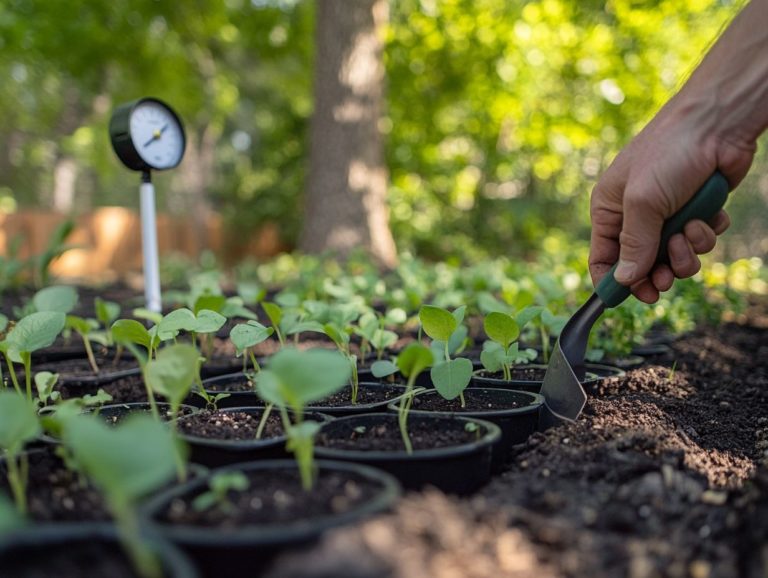How to Mulch for Maximum Moisture Retention
Mulching goes beyond just a gardening trend; it s an essential technique poised to transform your outdoor sanctuary.
This article delves into the essence of mulching, exploring its various types and highlighting its critical role in moisture retention.
Discover the advantages of both organic and inorganic mulches, along with key factors to consider when selecting the ideal option for your garden. You ll also find practical tips for applying it with finesse.
Dive in to uncover how you can improve your garden s vitality while conserving water efficiently!
Contents
- Key Takeaways:
- What is Mulching?
- Types of Mulch
- Benefits of Mulching for Moisture Retention
- Factors to Consider when Choosing Mulch
- How to Properly Mulch for Maximum Moisture Retention
- Mulching Tips and Tricks
- Frequently Asked Questions
- What is mulch and how does it help with moisture retention?
- What type of mulch is best for maximum moisture retention and soil temperature regulation?
- How thick should the mulch layer be for maximum moisture retention?
- When is the best time to mulch for maximum moisture retention?
- How often should I reapply mulch for maximum moisture retention?
- Are there any tips for mulching in areas with heavy rainfall?
Key Takeaways:

What is Mulching?
Mulching involves applying a layer of material on the soil’s surface. It offers a multitude of benefits, enhancing soil moisture, managing weeds, and regulating temperature, all contributing to healthier, more vigorous plant growth.
Common organic mulches, such as straw, grass clippings, and bark chippings, work wonders in your garden! If you’re feeling adventurous, inorganic options like plastic or rubber are also available.
Grasping the fundamentals of mulching can improve your gardening skills, promoting moisture retention and how well plants take in nutrients. It’s a vital component of any successful gardening routine.
Definition and Purpose
The primary purpose of mulching is to improve soil moisture retention. It also helps to minimize weed growth, which is crucial for nurturing healthy plants.
Beyond these fundamental benefits, mulching plays a variety of essential roles in your gardening practices. By covering the soil, it creates a protective barrier that shields plant roots from extreme temperature fluctuations, keeping them cooler in the summer and warmer during the colder months.
This layer aids in moisture regulation and improves soil structure how soil particles are arranged over time as organic matter decomposes, enriching the soil with vital nutrients.
In settings like vegetable gardens or flower beds, mulch can significantly reduce the need for frequent watering, making it especially advantageous in regions prone to drought. Effective weed control through mulching can lead to healthier plants and a more visually appealing environment.
Types of Mulch
Mulch can be elegantly divided into organic and inorganic types, each presenting distinct benefits for your gardening and landscape management endeavors.
Organic mulches think straw, compost, and woody materials enrich the soil as they break down, nurturing your garden from below. In contrast, inorganic mulches, such as plastic and gravel, offer enduring coverage without contributing nutrients.
By grasping the nuances between these options, you can make informed choices about the mulch techniques that best align with your goals, whether it s enhancing moisture retention, controlling weeds, or regulating soil temperature.
Get started with mulching today and transform your garden into a thriving oasis!
Organic vs. Inorganic
Organic mulches, made from biodegradable materials like compost, straw, and bark chippings, naturally improve soil health. In contrast, inorganic mulches like plastic and rubber provide a long-lasting solution for keeping your garden moist and controlling weeds.
Both types of mulches have unique advantages and drawbacks that can significantly impact your gardening results. Organic mulches enhance soil fertility as they decompose, promoting healthy microbial activity and attracting earthworms that aerate and enrich the soil.
On the flip side, inorganic mulches excel in durability and moisture retention, making them perfect for areas with harsh weather where consistency is crucial. When choosing between the two, think about your climate, the plants you re growing, and the level of maintenance you re willing to manage.
This way, you can ensure your choice aligns with your gardening goals and your commitment to environmental sustainability.
Benefits of Mulching for Moisture Retention

Mulching brings incredible benefits that can transform your garden! It is essential for conserving water and protecting your plants from drought.
By maintaining consistent soil moisture levels, mulch effectively reduces evaporation and soil erosion the loss of topsoil due to water or wind while stabilizing soil temperature, which creates a great environment for roots to thrive.
This water conservation technique enhances plant growth and aids nutrient absorption, fostering a healthier garden ecosystem.
Conserving Water and Improving Soil Quality
Mulching is a vital practice for conserving water and improving soil quality, reducing the need for frequent watering.
Covering your soil with organic materials like wood chips, straw, or shredded leaves significantly decreases evaporation rates. This helps keep moisture available for your plants during dry spells.
Studies show that mulching can cut water loss from evaporation by up to 50%, allowing your garden to thrive even in arid conditions.
As the organic matter decomposes, it enriches the soil with essential nutrients, improving its structure and fertility. To maximize your gardening success, layer your mulch to a depth of 2 to 4 inches. This not only retains moisture but also keeps weeds at bay, creating an ideal growth environment for your plants.
Factors to Consider when Choosing Mulch
When selecting the best mulch for your gardening needs, it s crucial to consider several key factors, such as climate, soil type, and the specific needs of your plants. This thoughtful approach will help you enhance moisture retention and promote healthy growth.
Climate, Soil Type, and Plant Needs
Understanding your local climate, soil type, and the specific requirements of your plants is vital when choosing the right mulch to boost moisture retention and overall plant health.
If you live in an arid region with high evaporation, a thicker layer of organic mulch can significantly reduce soil moisture loss. In cooler climates, various mulching materials can preserve warmth and protect root systems during frosty nights.
Soil type is just as important; if you have sandy soil, heavier mulch can help slow down drainage, while clay soils, which tend to compact, benefit from lighter mulches that enhance aeration.
Different plants have unique needs too. For instance, acid-loving plants like blueberries thrive with pine bark mulch, which conserves moisture while acidifying the soil.
By tailoring your mulching strategies to these factors, you’ll likely see improved plant vitality and resilience against environmental stresses.
How to Properly Mulch for Maximum Moisture Retention
To achieve maximum moisture retention through mulching, you must use proper techniques that guarantee optimal coverage and effectiveness in your garden, such as those outlined in maximizing soil moisture.
Step-by-Step Guide

Following a step-by-step mulching technique can significantly elevate your gardening experience. This technique enhances moisture retention while streamlining your routine.
This method helps create a vibrant garden where your plants thrive! Start by preparing the soil: clear away any debris, from pesky weeds to old plant material, to create a pristine foundation. This not only fosters healthier plant growth but also minimizes competition for vital nutrients.
Once your soil is prepped, selecting the right type of mulch organic options like straw, wood chips, or grass clippings can make a remarkable difference.
When applying mulch, spread it evenly around the base of your plants. Ensure it doesn’t touch the stems to avoid any risk of rot. Regular maintenance is key. Check moisture levels and replenish your mulch as needed to reap the maximum benefits throughout your gardening journey.
Mulching Tips and Tricks
Implementing effective mulching techniques can significantly enhance your water conservation efforts while enriching your overall gardening experience.
Additional Strategies for Water Conservation
Incorporating additional strategies for water conservation alongside mulching elevates your gardening practices to new heights.
Embrace efficient irrigation techniques, like drip irrigation, which waters plants slowly at their roots. This minimizes evaporation and runoff. Soil amendments, such as organic matter and compost, enhance moisture retention and improve soil structure. They create a nurturing environment for your plants. Companion planting supports a diverse array of plant species, reducing pests and enhancing water retention in the soil.
When you combine these strategies with mulching, which acts as a moisture-retentive barrier, you create a holistic approach. This not only conserves water but also cultivates a thriving ecosystem in your garden.
Watch this video to learn more about effective mulching techniques and water conservation methods!
Frequently Asked Questions
What is mulch and how does it help with moisture retention?
Mulch is a layer of organic or inorganic material spread over the soil surface. It prevents moisture from evaporating, keeping the soil moist for longer periods.
What type of mulch is best for maximum moisture retention and soil temperature regulation?

Organic mulches, such as wood chips, straw, and leaves, are the most effective at retaining moisture. They also add nutrients to the soil as they break down.
How thick should the mulch layer be for maximum moisture retention?
The ideal thickness for a mulch layer is 2-3 inches. This thickness retains moisture and suppresses weed growth without suffocating plant roots.
When is the best time to mulch for maximum moisture retention?
Mulching in the spring, before the hot summer months, is the best time for maximum moisture retention. This helps keep the soil moist during dry spells.
How often should I reapply mulch for maximum moisture retention?
Be sure to refresh your mulch every 1-2 years for the best results! It breaks down and decomposes over time. However, if the layer remains at least 2 inches thick, reapplication may not be necessary.
Are there any tips for mulching in areas with heavy rainfall?
If you live in an area with heavy rainfall, consider using a heavier mulch, such as pine bark nuggets, to prevent it from washing away. Avoid over-mulching, as this can create waterlogged conditions for plant roots.
Start mulching today for a flourishing garden tomorrow!






